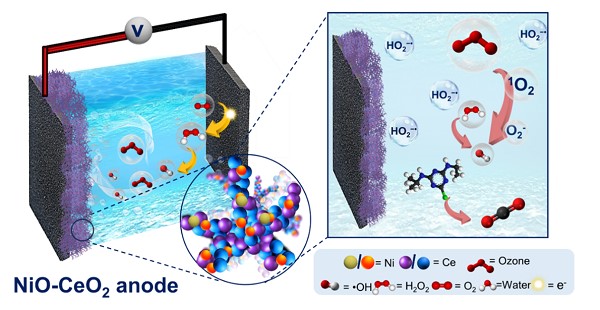Electrocatalytic Ozonation (ECO) Process and Electrocatalyst developed by Professor Min Jang’s team
- admin
- 2024-10-06
- 1953
·
Professor Min Jang’s Research
Team (Department of Environmental Engineering) Develops Electrocatalytic
Ozonation (ECO) Process and Electrocatalyst for Treating Trace Organic
Pollutants :
Elucidation of Metal Oxidation-Reduction Behavior Using In-situ Raman
- Published in the prestigious scientific journal Applied Surface Science (JCR IF: 6.3, 1st in Materials Science (Coatings & Films), JCR percentile: 97.83%) -

Nur Haslina Abd Rahman (Researcher), Dr. Geondeok Hwang, Research Professor Choeun Jong, and Professor Min Jang
Professor Min Jang’s research team―which includes PhD student Nur Haslina Abd Rahman (first author) from the Department of Environmental Engineering, Dr. Geondeok Hwang, and Research Professor Choeun Jong (co-corresponding authors)―has developed an electrocatalytic ozonation (ECO) process and redox catalyst capable of effectively treating water contaminated with trace organic pollutants. Professor Min Jang is the corresponding author, Deputy Director of the PBRC Research Center, and Director of the Environmental Nanotechnology Laboratory (JENTL).
The research, published in Applied Surface Science, the top journal in the field of surface coatings, demonstrates the use of a NiO-CeO₂ redox catalyst with oxygen vacancies (OV) to enhance ECO performance. The study shows the potential for large-scale applications to remove trace organic pollutants.
Pharmaceuticals and pesticides pose significant ecological and health risks due to their persistence and resistance to degradation. ECO has emerged as a key technology for removing these pollutants, such as pharmaceuticals and pesticides, from water sources. Traditional ozone treatment methods, while commonly used in water treatment, suffer from low efficiency due to poor solubility, slow reaction rates, and high energy consumption. This study maximized water treatment efficiency by using a NiO-CeO₂ catalyst with a high OV content, effectively converting ozone into highly oxidizing hydroxyl radicals (·OH) in an electrochemical cell, maintaining water treatment efficiency without metal leaching.
Professor Min Jang’s research team achieved a 3.4-fold increase in the dechlorination efficiency of atrazine (ATZ), a herbicide resistant to conventional ozone treatment, while reducing energy consumption by 84.4%. Advanced tools, such as in-situ Raman spectroscopy, were employed to clarify how metal interactions and redox reactions in the NiO-CeO₂ catalyst improve the degradation of trace organic pollutants at higher speeds and energy efficiencies.
As concerns grow globally over water pollution caused by trace organic pollutants, the developed ECO process and electrocatalyst show promise as an effective solution for the dechlorination of highly toxic trace organic pollutants.


This research was supported by the Basic Science Research Program through the National Research Foundation of Korea (NRF), funded by the Ministry of Education, under the 2024 grant from the Seoul Green Environment Center (SGEC, Korea 22-01-04-02-14) at Kwangwoon University (Grant Number: 2023R1A2C1003464) and by the Korea Environmental Industry & Technology Institute (KEITI) (Project Number RS-2023-00215807). The research findings were published online on September 6 in the scientific journal 'Applied Surface Science,' under the title 'Elucidation of the Role of Oxygen Vacancies in NiO-CeO2 Reduction Catalysts for Electrocatalytic Ozonation.'
Web link: https://www.sciencedirect.com/science/article/pii/S0169433224018889